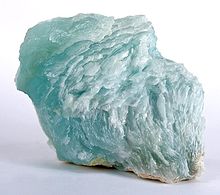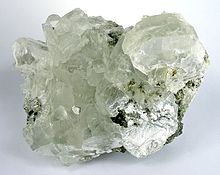Brucite
| Brucite | |
|---|---|
| Brucite from Wood's Chrome Mine, Pennsylvania, USA | |
| General and classification | |
| chemical formula | Mg (OH) 2 |
|
Mineral class (and possibly department) |
Oxides and hydroxides |
|
System no. to Strunz and to Dana |
4.FE.05 ( 8th edition : IV / F.03) 02/06/01/01 |
| Similar minerals | Talc , chlorite , mica |
| Crystallographic Data | |
| Crystal system | trigonal |
| Crystal class ; symbol | ditrigonal-scalenohedral; 3 2 / m |
| Space group | P 3 m 1 (No. 164) |
| Lattice parameters | a = 3.15 Å ; c = 4.77 Å |
| Formula units | Z = 1 |
| Frequent crystal faces | {11 2 0}, {10 1 1}, {01 1 3} |
| Physical Properties | |
| Mohs hardness | 2.5 |
| Density (g / cm 3 ) | measured: 2.39; calculated: 2.368 |
| Cleavage | completely after (0001) |
| colour | colorless, white, gray, yellow, brown, bluish, greenish |
| Line color | White |
| transparency | transparent to opaque |
| shine | Glass luster, mother-of-pearl luster on split surfaces |
| Crystal optics | |
| Refractive indices |
n ω = 1.560 to 1.590 n ε = 1.580 to 1.600 |
| Birefringence | δ = 0.020 |
| Optical character | uniaxial positive |
Brucite is a rather seldom occurring mineral from the class of " oxides and hydroxides ". It crystallizes in the trigonal crystal system with the composition Mg (OH) 2 , so from a chemical point of view it is a magnesium hydroxide .
Brucite usually develops needle-like or tabular crystals , but is also found in the form of leafy, rosette-shaped, granular, fibrous or massive mineral aggregates up to 50 cm in size. Unharmed crystal surfaces have a glass-like sheen , whereas cleavage surfaces have a mother-of-pearl shimmer.
In its pure form, brucite is colorless and transparent. In the case of multicrystalline formation, however, it can also appear white due to multiple light refraction and can take on a gray, yellow, brown, greenish or bluish color due to lattice construction errors or foreign admixtures, with the transparency decreasing accordingly. However, the line color is always white.
Etymology and history
Brucite was first discovered in 1824 in Castle Point near Hoboken in the US state of New Jersey and described by François Sulpice Beudant , who named the mineral after the American mineralogist Archibald Bruce (1777-1818).
classification
In the now outdated, but still in use, 8th edition of the mineral classification according to Strunz , brucite still belongs to the general division of "hydroxides and oxidic hydrates" ( oxides containing water of crystallization ), where it is found together with amakinite , ashoverite , para-otwayite , portlandite , pyrochroit , Spertiniit , Sweetit , Theophrastit and Wülfingit form an independent group.
The 9th edition of Strunz's mineral systematics , which has been in effect since 2001 and is also used by the International Mineralogical Association (IMA), lists brucite under the section "Hydroxides (without V or U )" and there in the sub-section of "Hydroxides with OH, without H 2 O; with layers of edge-linked octahedra ”, where it forms the unnamed group 4.FE.05 together with amakinite, fougèrite , portlandite, pyrochroite and theophrastite .
The systematics of minerals according to Dana , which is common in the English-speaking world , assigns brucite to the division of "hydroxides and hydroxy- containing oxides" and there in the sub-division of " hydroxides and hydroxy-containing oxides with the formula X 2+ (OH) 2 ". Here the mineral is named after the "brucite group (rhombohedral: P 3 m 1)" with the system no. 02/06/01 and the other members amakinite, pyrochroit, portlandite and theophrastite.
Crystal structure
Brucite crystallizes trigonally in the space group P 3 m 1 (space group no. 164) with the lattice parameters a = 3.15 Å and c = 4.77 Å and one formula unit per unit cell .
The structure of brucite consists of two OH layers arranged in the manner of the hexagonal closest packing of spheres . The octahedrally coordinated Mg cations are located in the spaces between the OH layers . These layers continue indefinitely in two spatial directions ( crystallographic a and b axes). In the direction of the c-axis, neighboring layers are only held together by a relatively weak van der Waals bond , which is also the reason for the mineral's perfect cleavability.
This so-called brucite layer (OH layers with a central cation layer) is a fundamental component of the structure of sheet silicates .
properties
Contrary to other sources, brucite is not able to show pyroelectric or piezoelectric effects due to its centrosymmetrical crystal structure . Pyro- and piezoelectric effects are described by a polar vector, but crystals with an inversion center are non-polar (see also Neumann's principle ).
In front of the soldering tube , brucite becomes cloudy, but does not melt. However, it is very sensitive to acids and dissolves easily even in dilute acids .
Modifications and varieties
In brucite, Mg 2+ can be replaced to a limited extent by Fe 2+ and Mn 2+ ( substitution ), with iron-containing brucite also being referred to as ferrobrucite and those containing manganese as manganese brucite . Nemalith , on the other hand, is a morphological variety of brucite in which the crystals have a fibrous habit .
In ferrobrucite , up to 36% Mg 2+ can be replaced by Fe 2+ , which makes this variety very unstable. The fresh from the mine brought to light Ferrobrucit is initially colorless and transparent, but then changes within a few days its color from golden yellow to brown to a dark brown opaque. The reason for this is the atmospheric oxygen, which causes the iron to oxidize from Fe 2+ to Fe 3+ . In addition, this transformation causes a disruption of the crystal lattice until it is completely dissolved. Ferrobrucite becomes amorphous , i.e. H. Despite the retention of the external crystal shape, no internal order between the crystal building blocks can be determined even with the help of X-ray structure analysis.
Education and Locations
In nature, brucite is formed almost exclusively during metamorphosis . It arises from the transformation of magnesium-rich minerals such as dolomite , forsterite and periclase . Brucite is a characteristic mineral for serpentinite and shows formation temperatures of <400 ° C. Brucite is also found in marbles or as a fissure mineral . Artificial brucite can be created as a component of the scale .
As a rather rare mineral formation, brucite can be partly abundant in different places, but overall it is not very common. Around 460 sites are known to date (as of 2017).
The “Wood's Chrome Mine” near Texas in Lancaster County (Pennsylvania) , where crystals of up to 19 cm in size were discovered (see picture opposite) as well as the “Low's Mine” (also Pennsylvania) and the “ Tilly Foster Iron Mine ”near Brewster in Putnam County (New York) , which produced crystals up to 18 cm in size. Crystals up to 10 cm in size are known from the “Bazhenovskoe” deposit near asbestos in the Russian Oblast of Sverdlovsk (see picture opposite). A bluish crystal specimen from the same site on display in the terra mineralia in Freiberg is said to have a size of 20 cm × 14 cm × 4 cm.
In Germany, the mineral has so far been found in the Zeilberg quarry near Maroldsweisach in Bavaria, in a gabbro quarry in the Radau valley near Bad Harzburg (see also Harzburger Gabbro ) in Lower Saxony, on a slag dump in the Genna zinc smelter near Letmathe in North Rhine-Westphalia, at several locations in the Eifel ( Arensberg , Bellerberg volcano , Friedrichssegen pit , Hangelberg) and on the Lichtenberg waste dump near Ronneburg in Thuringia.
In Austria, brucite was found in a marble quarry near Kochholz in the community of Dunkelsteinerwald and near Loja in the community of Persenbeug-Gottsdorf in Lower Austria; in a basalt quarry near Klöch , in a serpentinite outcrop at Eibegggraben near Sankt Jakob-Breitenau , in a hard stone quarry near Sankt Lorenzen near Knittelfeld and in several places in the south of the Leoben district in Styria and at Furtschaglkar in the Schlegeisgrund of the Zillertal in North Tyrol.
In Switzerland, the mineral has only been discovered in Val Forno, a side valley of Bergell in the canton of Graubünden, and in the Rimpfischwäng on the Findel glacier near Zermatt in the canton of Valais .
Other locations include the Antarctic, Ethiopia, Australia, Brazil, Chile, China, the Dominican Republic, Finland, France, Ghana, Greece, Indonesia, Ireland, Israel, Italy, Japan, Jordan, Canada, Libya, Morocco, Mexico, Namibia, Nepal, New Zealand, North Korea, Norway, Oman, Pakistan, Poland, Romania, Sweden, Zimbabwe, Slovakia, Spain, South Africa, Taiwan, Czech Republic, Tuvalu, Turkey, Ukraine, Hungary, United Kingdom (UK) and the United States of America (USA).
Brucite could also be detected in soil samples from the prospecting borehole "DSDP hole 778" from the Mariana Trench in the Pacific Ocean.
use
Brucite is a raw material for the manufacture of refractory materials. In the chemical industry, man-made magnesium hydroxide is mainly used.
See also
literature
- Hans Jürgen Rösler : Textbook of Mineralogy . 4th revised and expanded edition. German publishing house for basic industry (VEB), Leipzig 1987, ISBN 3-342-00288-3 , p. 423-424 .
- Helmut Schrätze , Karl-Ludwig Weiner : Mineralogy. A textbook on a systematic basis . de Gruyter, Berlin; New York 1981, ISBN 3-11-006823-0 , pp. 483-484 .
Web links
- Mineral Atlas: Brucite (Wiki)
- RRUFF Database-of-Raman-spectroscopy - Brucite
- American-Mineralogist-Crystal-Structure-Database - Brucite
Individual evidence
- ↑ a b c d Hugo Strunz , Ernest H. Nickel : Strunz Mineralogical Tables. Chemical-structural Mineral Classification System . 9th edition. E. Schweizerbart'sche Verlagbuchhandlung (Nägele and Obermiller), Stuttgart 2001, ISBN 3-510-65188-X , p. 237 .
- ↑ Webmineral - Brucite (English)
- ^ A b c d Helmut Schrätze , Karl-Ludwig Weiner : Mineralogie. A textbook on a systematic basis . de Gruyter, Berlin; New York 1981, ISBN 3-11-006823-0 , pp. 483-484 .
- ↑ a b c d Brucite . In: John W. Anthony, Richard A. Bideaux, Kenneth W. Bladh, Monte C. Nichols (Eds.): Handbook of Mineralogy, Mineralogical Society of America . 2001 ( handbookofmineralogy.org [PDF; 70 kB ; accessed on February 26, 2017]).
- ↑ a b c d Mindat - Brucite
- ↑ a b c d Friedrich Klockmann : Klockmann's textbook of mineralogy . Ed .: Paul Ramdohr , Hugo Strunz . 16th edition. Enke, Stuttgart 1978, ISBN 3-432-82986-8 , pp. 550 (first edition: 1891).
- ↑ Walter Borchardt-Ott: Crystallography . 6th edition. Springer-Verlag, Berlin 2002, ISBN 3-540-43964-1 , pp. 158-160, 164 .
- ↑ a b A. G. Betechtin (А. Г. Бетехтин): Textbook of special mineralogy . 2nd Edition. VEB Verlag Technik, Berlin 1957, p. 48 (Russian: Курс минералогии . Translated by Wolfgang Oestreich).
- ↑ Mindat - Number of localities for Brucite
- ↑ Petr Korbel, Milan Novák: Mineral Encyclopedia (= Dörfler Natur ). Nebel Verlag, Eggolsheim 2002, ISBN 978-3-89555-076-8 , p. 109 .
- ↑ Mindat - picture of a 20 cm large brucite crystal specimen from Bazhenovskoe, Asbest, Sverdlovsk, Russia. Exhibited in the terra mineralia
- ↑ a b List of places where brucite was found in the Mineralienatlas and Mindat



